Where to Safari in the USA
5 places to see spectacular animal migrations without leaving the US
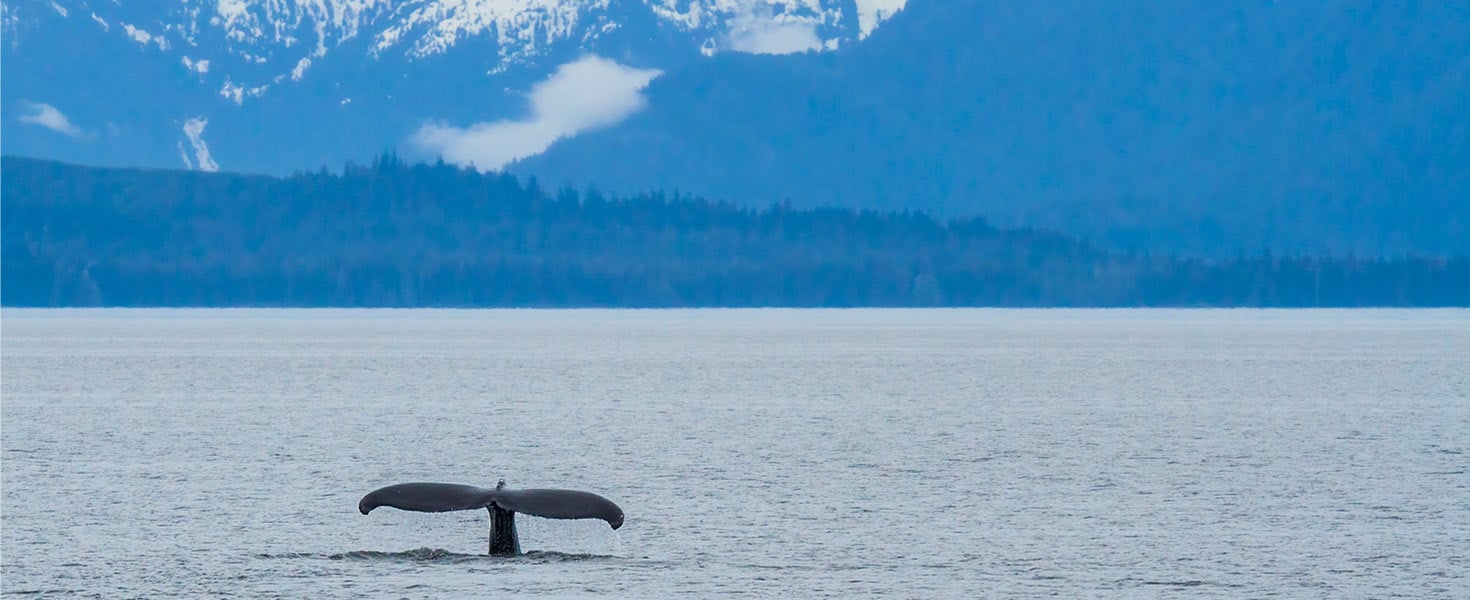
For many people (us included!), seeing the epic migration in Tanzania’s Serengeti is a life goal. In the meantime, there are amazing migrations to see right here in the US, and they span the animal kingdom, including insects, birds, sea life and land mammals. Here, we share spectacular migrations and mating scenes witnessed by our writers.
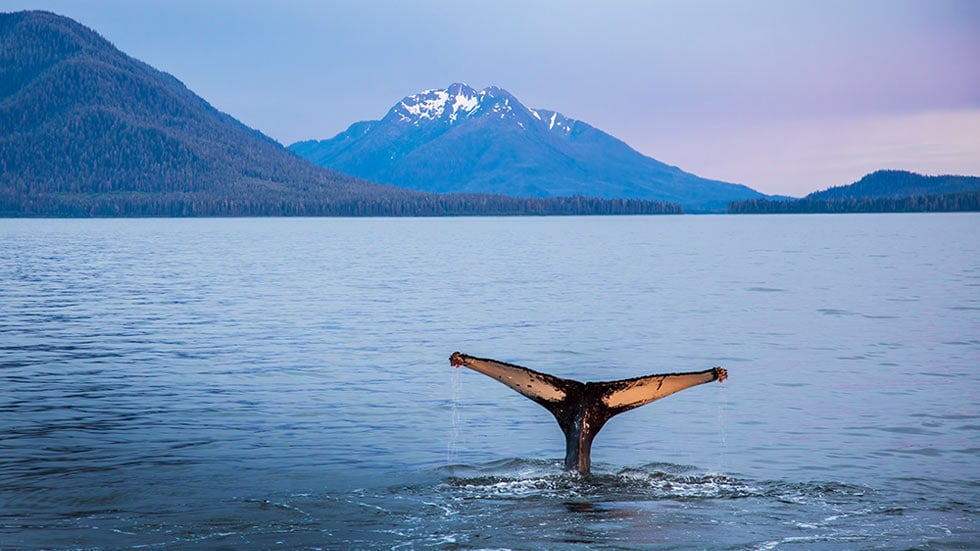 Humpback Whale Migration; Photo by Eric Lindberg
Humpback Whale Migration; Photo by Eric Lindberg
PACIFIC PASSAGE
Awe-inspiring humpback whales can be seen at both ends of their remarkable journey between Alaska and Hawaii.
By Eric Lindberg
Somewhere off Chichagof Island, tiny droplets of mist swirl around us. Standing in full rain gear by the rail of Uncruise Adventure’s small ship Wilderness Explorer, nine other passengers and I scan the glassy surface for a ripple, a disturbance, any sign of the massive creatures somewhere below. Suddenly, the water 30 yards off the bow erupts as a humpback whale rockets upward and breaches, briefly suspended before dropping back down with a powerful splash.
From that moment, I was hooked. My first encounter with humpback whales has led to many more. For the past 15 years, I’ve made numerous trips here to Alaska’s Inside Passage and to Hawaii in search of these intelligent cetaceans.
In one of the planet’s epic migrations, up to 10,000 humpback whales travel 3,000 miles annually between Alaska and Hawaii. Whether on small ships or day tours from Alaska’s capital of Juneau, I’ve seen humpbacks each time I sought them out.
Sometimes, it’s a long gray back slicing through the water or a slap of flukes or fins. Occasionally, I’ve been lucky enough to witness bubble feeding, a frenzy of gaping jaws and splashing torrents as a group rounds up fish and feeds at the surface. And perhaps best of all is watching a 30-ton humpback breach and then smash back into the ocean.
As the humpbacks return to Hawaii each winter, I follow. Joining a tour in Lahaina, Maui, we motor from the harbor. Five minutes later, our boat slows as humpbacks come into view on both sides. A large gray form veers directly toward us. Just before reaching us, the whale dives under our boat and emerges on the other side. We gasp with delight.
These are the oceanic encounters that thrill us. But even more remarkable is the journey the humpbacks make across the Pacific as well as along the Atlantic Seaboard—a passage that they will continue throughout their long lives.
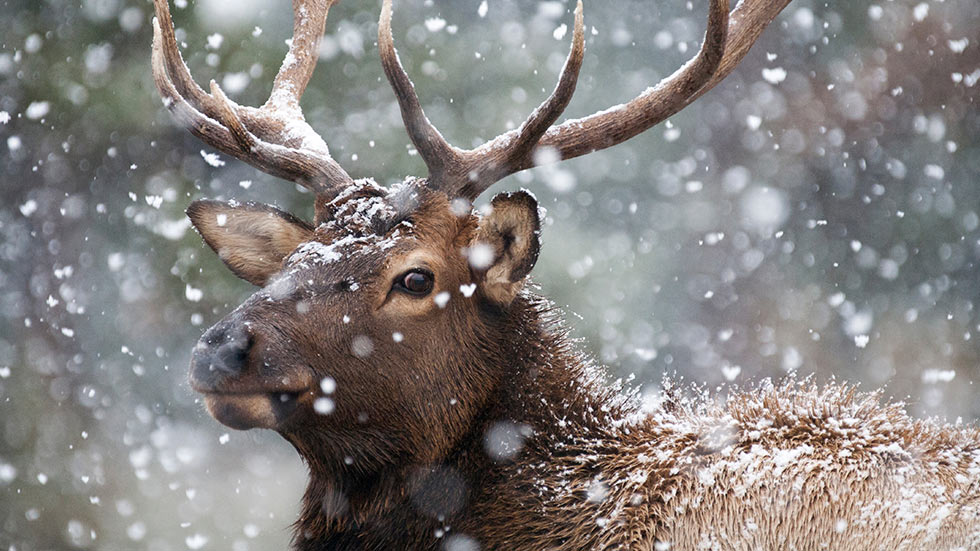 Photo by BradleyRWakoff/Stock.Adobe.com
Photo by BradleyRWakoff/Stock.Adobe.com
COLD QUARTERS
North America’s largest elk migration in winter is a sight to behold at Wyoming’s National Elk Refuge.
By Ted Alan Stedman
Huddled shoulder to shoulder on a horse-drawn sleigh, 15 tour members and I are intent on witnessing one of North America’s premier wildlife spectacles: the largest elk migration on the continent. Our exhaled breaths form a communal icy mist in minus-32-degree air that tastes like peppermint. Submitting ourselves to winter’s wrath seems counterintuitive, but cold is the necessary price of admission for our quest.
When winter descends on Jackson Hole, Wyoming, so do the elk. Historically, over 25,000 elk had made the 60-mile trek south annually from present-day Yellowstone National Park to their winter range in Jackson Hole. But by the end of the 19th century, the growth of the town of Jackson, hunting and brutal winters had drastically reduced the size of the elk herd, prompting the creation of the 24,700-acre National Elk Refuge and the elk feeding program that helps to sustain the creatures until spring. Today’s herd tallies approximately 11,000 elk, and roughly half of those winter within the refuge.
 Photo courtesy of National Elk Refuge Sleigh Rides
Photo courtesy of National Elk Refuge Sleigh Rides
Over the years, the herd has become a big draw for wildlife watchers. Outfitters, including National Elk Refuge Sleigh Rides, conduct daily one-hour tours from mid-December through early April.
From a distance, the refuge’s winter herd seems like a single organism, a reddish-brown palette contrasting with the blindingly white snowbound landscape. As our sleigh pulls closer, though, we distinguish individual elk: majestic 700-pound males sprouting antlers nearly four feet above their heads, occasionally jostling with other bulls, and stoic antlerless female cows weighing up to 500 pounds each, attentive to the calves that will leave their mothers come spring. The intense cold seems to subdue everything in its grip as the herd clusters together to maintain warmth while chomping on alfalfa scattered on the snow.
With the sound of snow crunching beneath our sleigh horse’s hooves, we move among the outskirts of the massive herd stretching north into the white horizon. It is a mesmerizing sight, one that’s repeated itself for thousands of years. And in that moment, there is no chatter among our group, just the sense that we are now spectators to a ritual as old as time.
 Photo by Songdech17/Stock.Adobe.com
Photo by Songdech17/Stock.Adobe.com
NATURE’S LIGHT SHOW
The mating ritual of synchronized fireflies creates a unique light show each June in Great Smoky Mountains National Park.
By Terri Colby
As the last hints of daylight disappear, a tiny, glowing insect glides through a clearing in the woods. A few feet away, another tiny light moves more slowly and closer to the ground. These early arrivals signal that the grand spectacle is about to begin.
My fellow visitors and I are here at Great Smoky Mountains National Park to witness an unusual phenomenon: the mating ritual of Photinus carolinus, one of only about one percent of the world’s 2,000 firefly species that flash synchronously as part of their annual mating ritual.
The dance begins slowly. One light here, another there. More fireflies join, and the rhythmic blinking commences, like camera flashes on a Hollywood red carpet. Flash, flash, flash, one after another. Then darkness. Incredible darkness.
Those of us watching are the fortunate few, chosen from nearly 25,000 who had entered the National Park Service’s online lottery for a spot during the eight-night firefly viewing taking place in June in a section of the park that was once the town of Elkmont, Tennessee.
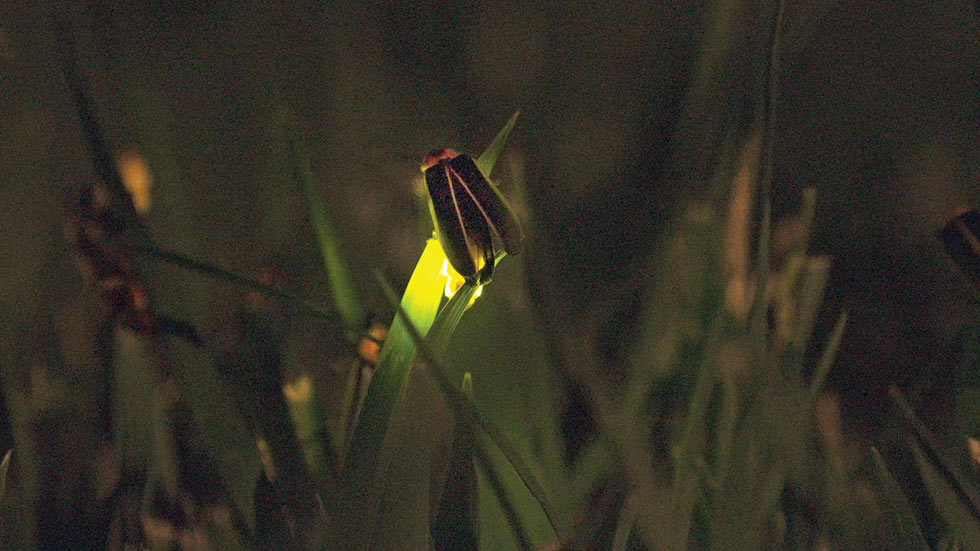 Photo by Jim Matheny
Photo by Jim Matheny
As the night deepens, the crisp white lights grow more brilliant and more persistent until close to 10 p.m., when the flashes move like a wave as throngs of male fireflies seek to attract the attention of the few females that wait near the ground.
The fireflies here didn’t attract wide notice until the early 1990s, when Tennessee naturalist Lynn Faust contacted scientists after reading about a Malaysian firefly species thought to be the only synchronous firefly in the world.
Faust had spent childhood summers in Elkmont, and she knew otherwise. She worked with scientists to help identify the Tennessee species and continued her firefly research for years, earning the moniker “the Lightning Bug Lady.” Her Fireflies, Glow-worms and Lightning Bugs is a comprehensive guide to fireflies in eastern and central North America.
Although a few other synchronous species have been identified in the US, Mexico, Thailand and Australia, they remain extremely rare. That makes the light show that takes place for two to three weeks each June a glowing attraction in Great Smoky Mountains National Park.
The National Park Service typically announces dates for the upcoming early to mid-June synchronous firefly viewing and the viewing lottery in late April at nps.gov/grsm/learn/nature/fireflies.htm.
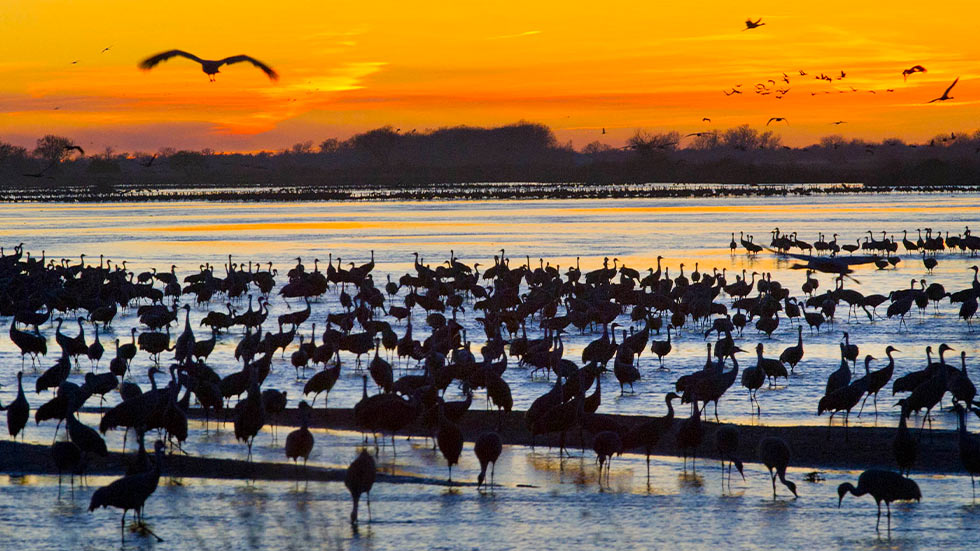 Courtesy of Nebraska Tourism
Courtesy of Nebraska Tourism
AS THE CRANE FLIES
Up to 80 percent of the world’s sandhill cranes migrate through the Plains, with Nebraska a favored rest stop.
By MeLinda Schnyder
We’ve been huddled inside a blind along south-central Nebraska’s Platte River for an hour, arriving well before dusk to go unnoticed when the sandhill cranes descend to roost for the night in the area’s shallow, braided river channels.
As the sun begins to set, transforming the sky from soft pink to blazing orange and then purple, those of us observing from the blind see ribbons of formation flying cranes.
Their distance makes them appear blurred, looking like “whiffs of smoke,” as conservationist Jane Goodall has described it. The magnificent birds—a species of large crane whose adults stand three to five feet tall, their gray bodies capped with a head marked by white cheeks and a red forehead—are traveling to the riverbed from their daytime retreats in nearby cornfields and wet meadows.
We stay quiet and still as the cranes begin to gather. Within minutes, a low-flying eagle startles the cranes, triggering mass departure. It’s amazing to witness some 15,000 pairs of wings making their frantic yet graceful escape, eliciting a sound like the roar of the crowd at a football stadium.
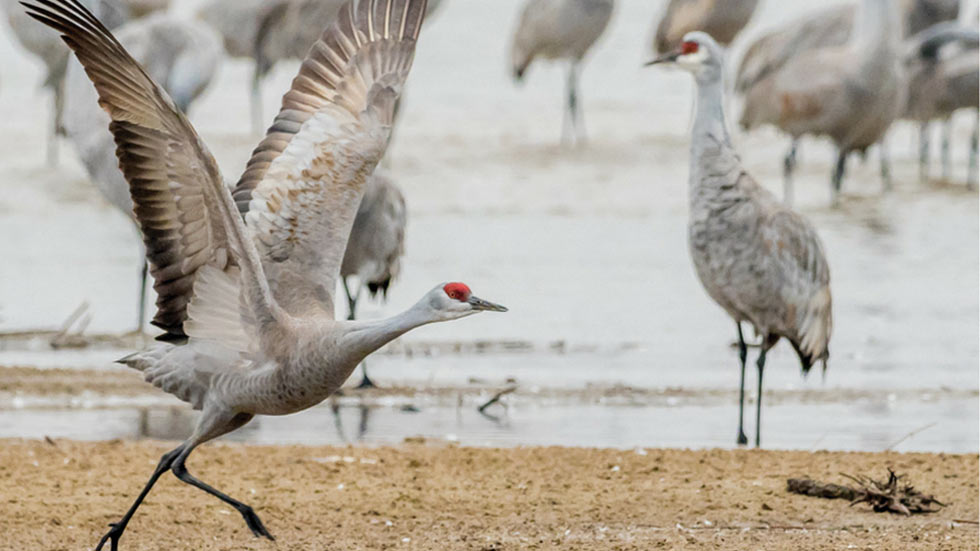 Photo by Mark Washburn/Rowe Sanctuary Photo Contest
Photo by Mark Washburn/Rowe Sanctuary Photo Contest
It is no wonder they are skittish: sandhill cranes have numerous predators and are hunted by humans in many areas.
After making an elegant circle, the cranes return to a sandbar, where they’re soon joined by thousands more. South-central Nebraska represents a major stopping point for the cranes as they migrate 4,000 to 5,000 miles each spring from as far south as Mexico to their summer ranges where they will breed, which can be as far north as Siberia.
It’s easy for travelers to experience the spectacle. Viewing blind tours at sunrise or sunset—offered by Crane Trust Nature & Visitor Center near Grand Island, Iain Nicolson Audubon Rowe Sanctuary near Kearney and Dusty Trails in North Platte—are generally the best way to see cranes up close. Other options include daytime-viewing bus tours, evening footbridge tours, overnight excursions and more. Or experience the migration on your own via free public viewing decks and turnouts on backroads or within several area state parks. See maps and start your research at NebraskaFlyway.com.
Virtual tours are available, too, but there’s nothing like being in the midst of what Goodall calls a “magical migration.”
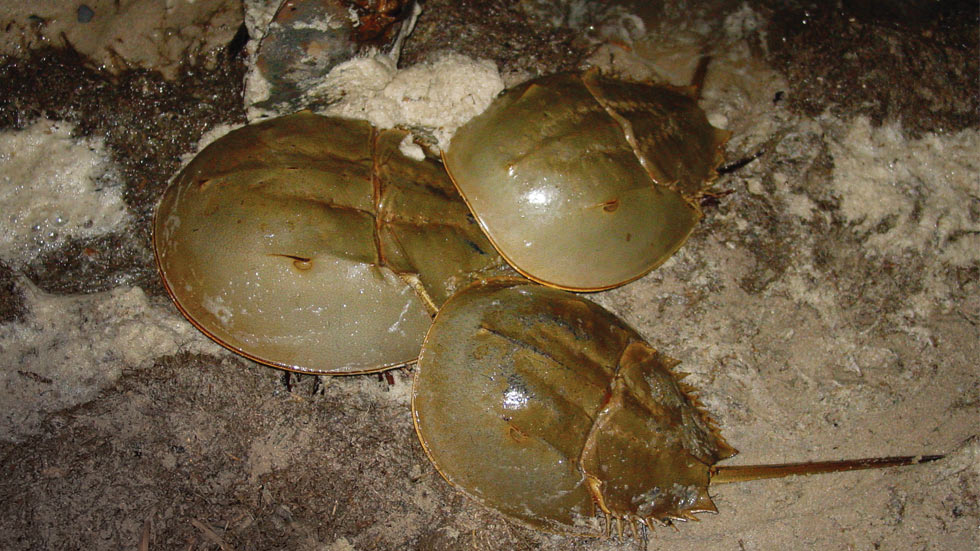 Photo by Theresa G. Medoff
Photo by Theresa G. Medoff
NIGHT OF THE LIVING FOSSILS
Every May and June, millions of horseshoe crabs come ashore along the Delaware Bay, their prime spawning grounds.
By Theresa Gawlas Medoff
On a moonlit night in early June, my friend and I join a group of other volunteers on a Delaware Bay beach for the annual Delaware Bay Horseshoe Crab spawning survey. These prehistoric creatures—they’ve been around for up to 480 million years—are threatened by coastal development and habitat loss from climate change. Thus, in 1999 began the spawning survey and other measures to ensure this species’ survival.
Despite their name, horseshoe crabs belong to the Arachnida genus, more closely related to spiders and scorpions than to crabs. But you’d never want to see a spider this big: females, the larger of the sexes, can grow to be 19 inches from head to tail.
Horseshoe crabs are quite odd-looking, their muddy gray exoskeleton bringing to mind a piece of armor or perhaps a slightly flattened helmet. The creature’s name comes from its rounded, u-shaped head, which slightly resembles the shoe of a horse. The middle section, its abdomen, is triangular with spiny projections on the side, and a stiff pointy tail emerges from behind. Flip it over, and you’ll see gills and five sets of legs.
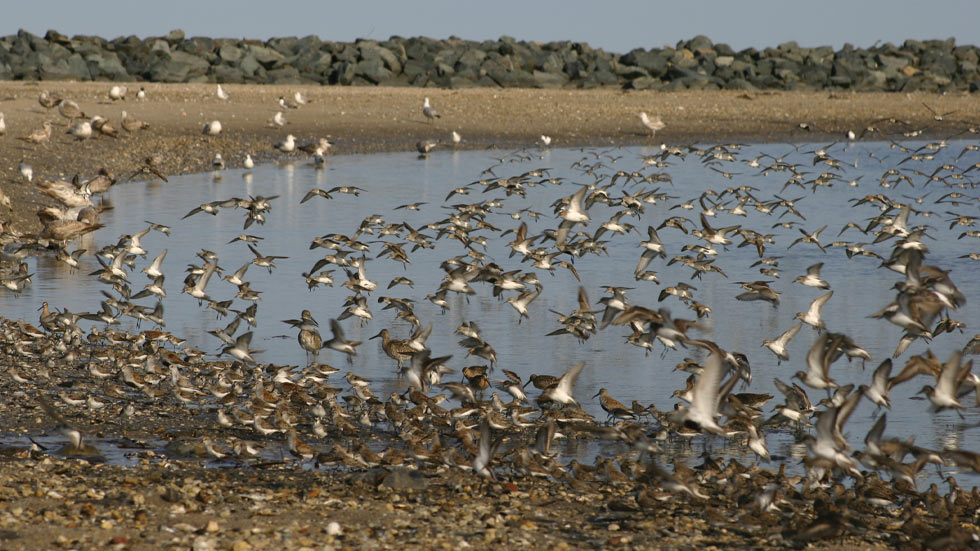 Shorebirds feast on horseshoe crab eggs; Courtesy of VisitSouthernDelaware.com
Shorebirds feast on horseshoe crab eggs; Courtesy of VisitSouthernDelaware.com
Though accustomed to seeing horseshoe crabs here and there on the beach, I am wholly unprepared for the sight this June night: teeming masses of horseshoe crabs all along the tideline, piled two or three on top of each other and a yard or more deep.
The Atlantic Horseshoe Crab (Limulus Polyphemus) can be found all along the Atlantic and Gulf Coasts and into northern Mexico (three other species exist in Southeast Asia). Although spawning starts in April and sometimes continues into July, the vast majority of horseshoe crabs spawn from May to mid-June on Delaware Bay beaches in Delaware and New Jersey.
They come ashore to spawn on the higher of two daily high tides, usually after dark. The female lays her eggs on the beach, where they are fertilized immediately, often by multiple males. One female can lay 80,000 to 100,000 eggs during the annual spawning period. Many of those eggs will be eaten by shorebirds, particularly endangered red knots, that stop over on the Delaware Bay on their spring migration from South America to the Canadian Arctic.
You can best see the phenomenon on Delaware Bay beaches during the migration season at the morning high tide after a full or nearly full moon (access to beaches is restricted at night). Visit the DuPont Nature Center (de.gov/dnc) on the bay in Milford, Delaware, or the Wetlands Institute (wetlandsinstitute.org) in Stone Harbor, New Jersey, to learn more about these fascinating ancient sea animals.
